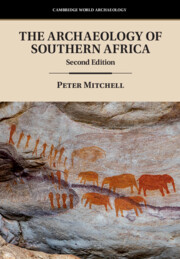Book contents
- Frontmatter
- Contents
- List of Figures
- List of Tables
- Acknowledgments
- 1 Introduction
- 2 Frameworks
- 3 Contexts
- 4 Origins
- 5 A Cognitive Revolution
- 6 Hunter-Gatherers of the Late Pleistocene
- 7 Archaeologies of the Pleistocene/Holocene Transition
- 8 Hunting, Gathering, Intensifying: Forager Histories in the Holocene before 2000bp
- 9 Taking Stock: Herders and Hunter-Gatherers
- 10 Farmers and Foragers: the First Millennium
- 11 Forming States: the Zimbabwe Culture and its Neighbours
- 12 Recent Farmers and Hunter-Gatherers in Southernmost Africa
- 13 Colonisation, Conquest, Resistance
- 14 Perspectives and Prospects
- Glossary
- References
- Index
12 - Recent Farmers and Hunter-Gatherers in Southernmost Africa
Published online by Cambridge University Press: 15 May 2024
- Frontmatter
- Contents
- List of Figures
- List of Tables
- Acknowledgments
- 1 Introduction
- 2 Frameworks
- 3 Contexts
- 4 Origins
- 5 A Cognitive Revolution
- 6 Hunter-Gatherers of the Late Pleistocene
- 7 Archaeologies of the Pleistocene/Holocene Transition
- 8 Hunting, Gathering, Intensifying: Forager Histories in the Holocene before 2000bp
- 9 Taking Stock: Herders and Hunter-Gatherers
- 10 Farmers and Foragers: the First Millennium
- 11 Forming States: the Zimbabwe Culture and its Neighbours
- 12 Recent Farmers and Hunter-Gatherers in Southernmost Africa
- 13 Colonisation, Conquest, Resistance
- 14 Perspectives and Prospects
- Glossary
- References
- Index
Summary
Just as the archaeology of the Zimbabwe Culture’s later phases (the Torwa and Mutapa states) can be understood as an exercise in historical archaeology structured by dialogue between the evidence of material culture and that of oral and written histories, so too can the recent past of farming communities and their neighbours south of the Limpopo. Here (and extending into modern Botswana), the archaeological record of the past several hundred years is that of the ancestors of today’s Sotho/Tswana, Nguni, Tsonga, and Venda peoples. This chapter therefore looks at the expansion of farming populations on to the temperate grasslands of South Africa’s interior; the multiple interactions between farmers, pastoralists, and hunter-gatherers (something also increasingly informed by genetics); early contacts with European traders on southern Africa’s Indian Ocean coast; the creative potential of cattle, metals, and other indigenous resources to generate power and wealth; the emergence of more complex societies and denser patterns of settlement; and the construction of new built landscapes that are only now beginning to be understood in detail (notably in Mpumalanga and Gauteng).
Keywords
- Type
- Chapter
- Information
- The Archaeology of Southern Africa , pp. 359 - 392Publisher: Cambridge University PressPrint publication year: 2024

